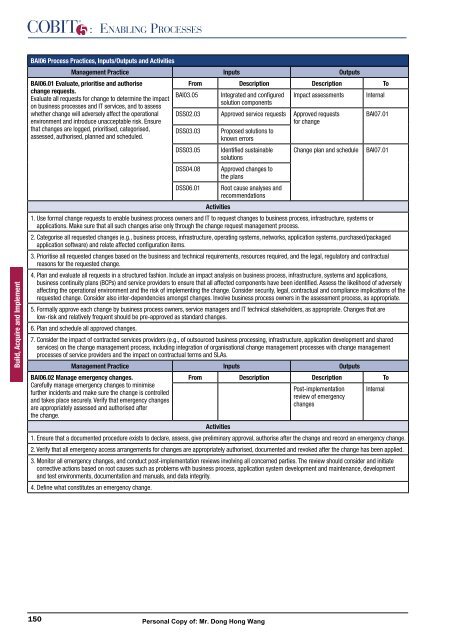Enabling Processes
Enabling Processes
Enabling Processes
Create successful ePaper yourself
Turn your PDF publications into a flip-book with our unique Google optimized e-Paper software.
Build, Acquire and Implement<br />
150<br />
: ENABLING PROCESSES<br />
BAI06 Process Practices, Inputs/Outputs and Activities<br />
Management Practice Inputs Outputs<br />
BAI06.01 Evaluate, prioritise and authorise<br />
From Description Description To<br />
change requests.<br />
Evaluate all requests for change to determine the impact<br />
on business processes and IT services, and to assess<br />
BAI03.05 Integrated and configured<br />
solution components<br />
Impact assessments Internal<br />
whether change will adversely affect the operational DSS02.03 Approved service requests Approved requests BAI07.01<br />
environment and introduce unacceptable risk. Ensure<br />
for change<br />
that changes are logged, prioritised, categorised,<br />
assessed, authorised, planned and scheduled.<br />
DSS03.03 Proposed solutions to<br />
known errors<br />
DSS03.05 Identified sustainable<br />
solutions<br />
Change plan and schedule BAI07.01<br />
DSS04.08 Approved changes to<br />
the plans<br />
DSS06.01 Root cause analyses and<br />
recommendations<br />
Activities<br />
1. Use formal change requests to enable business process owners and IT to request changes to business process, infrastructure, systems or<br />
applications. Make sure that all such changes arise only through the change request management process.<br />
�� ���������� ��� ��������� ������� ������ �������� �������� ��������������� ��������� �������� ��������� ����������� �������� ������������������<br />
application software) and relate affected configuration items.<br />
3. Prioritise all requested changes based on the business and technical requirements, resources required, and the legal, regulatory and contractual<br />
reasons for the requested change.<br />
4. Plan and evaluate all requests in a structured fashion. Include an impact analysis on business process, infrastructure, systems and applications,<br />
business continuity plans (BCPs) and service providers to ensure that all affected components have been identified. Assess the likelihood of adversely<br />
affecting the operational environment and the risk of implementing the change. Consider security, legal, contractual and compliance implications of the<br />
requested change. Consider also inter-dependencies amongst changes. Involve business process owners in the assessment process, as appropriate.<br />
5. Formally approve each change by business process owners, service managers and IT technical stakeholders, as appropriate. Changes that are<br />
low-risk and relatively frequent should be pre-approved as standard changes.<br />
6. Plan and schedule all approved changes.<br />
7. Consider the impact of contracted services providers (e.g., of outsourced business processing, infrastructure, application development and shared<br />
services) on the change management process, including integration of organisational change management processes with change management<br />
processes of service providers and the impact on contractual terms and SLAs.<br />
Management Practice Inputs Outputs<br />
BAI06.02 Manage emergency changes.<br />
From Description Description To<br />
Carefully manage emergency changes to minimise<br />
further incidents and make sure the change is controlled<br />
��� ����� ����� ��������� ������ ���� ��������� �������<br />
are appropriately assessed and authorised after<br />
the change.<br />
Post-implementation<br />
review of emergency<br />
changes<br />
Internal<br />
Activities<br />
1. Ensure that a documented procedure exists to declare, assess, give preliminary approval, authorise after the change and record an emergency change.<br />
�� ������ ���� ��� ��������� ������ ������������ ��� ������� ��� ������������� ����������� ���������� ��� ������� ����� ��� ������ ��� ���� ��������<br />
3. Monitor all emergency changes, and conduct post-implementation reviews involving all concerned parties. The review should consider and initiate<br />
corrective actions based on root causes such as problems with business process, application system development and maintenance, development<br />
and test environments, documentation and manuals, and data integrity.<br />
4. Define what constitutes an emergency change.<br />
Personal Copy of: Mr. Dong Hong Wang


